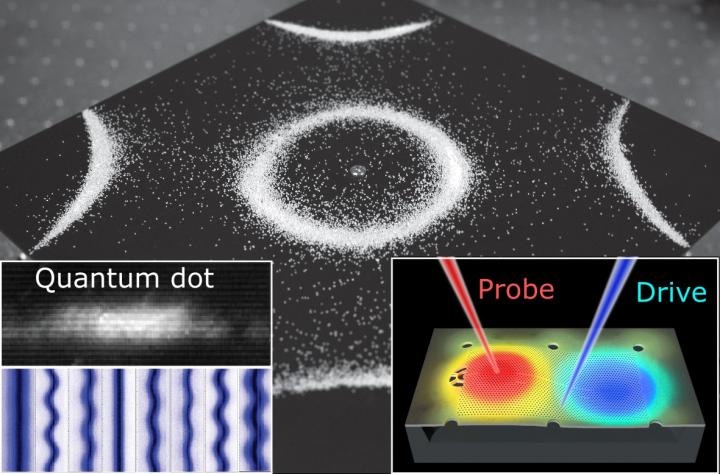Oct 31 2017
Ernst Chladni, a scientist and musician, discovered that the vibrations of a rigid plate could be visualized by covering it with a thin layer of sand and drawing a bow across its edge. This discovery took place in the late 18th century.
The sand bounces and shifts with the bow movement, thereby collecting along the nodal lines of the vibration. The discovery of these patterns earned Chladni the nickname, "father of acoustics." His discovery is still used in the design and construction of acoustic instruments, such as violins and guitars.
 Background: Image of a Chladni plate's mode of vibration visualized by grains of sand collected at the nodes. Left-top: Cross-sectional scanning tunneling microscopy image of an indium arsenide quantum dot. Left-bottom: Variation of quantum dot emission line frequencies as a function of time due to vibrations of the photonic crystal membrane. Right: Scanning electron micrograph of a photonic crystal membrane, displaced according to one of the vibrational modes, with red and blue representing positive and negative displacement, respectively. CREDIT Sam Carter and co-authors
Background: Image of a Chladni plate's mode of vibration visualized by grains of sand collected at the nodes. Left-top: Cross-sectional scanning tunneling microscopy image of an indium arsenide quantum dot. Left-bottom: Variation of quantum dot emission line frequencies as a function of time due to vibrations of the photonic crystal membrane. Right: Scanning electron micrograph of a photonic crystal membrane, displaced according to one of the vibrational modes, with red and blue representing positive and negative displacement, respectively. CREDIT Sam Carter and co-authors
Investigators recently discovered a similar effect with much smaller vibrating objects excited by light waves. When laser light is employed to drive the motion of a thin, rigid membrane, it acts as the bow in Chladni's original experiment and the membrane then vibrates in resonance with the light. It is possible to visualize the resulting patterns via an array of quantum dots (QDs), where these small structures emit light at a frequency that responds to movement. The advance has recently been reported in a cover article of Applied Physics Letters, by AIP Publishing.
As well as being a modern take on an old phenomenon, this new discovery could also lead to the production of sensing devices and also methods used for controlling the emission characteristics of QDs. The light frequency emitted by the QDs is connected with the movement of the underlying membrane, and this allows envisioning new devices for sensing motion, such as accelerometers. It is also possible to have a reverse application since the motion of the underlying membrane can be employed for controlling the frequency of light emitted by the QDs.
The small devices in the work reported here comprise of a 180 nm thick slice of semiconductor, suspended like a trampoline over a solid substrate. An array of QDs, similar to the sand in the acoustic example, are inserted in the slice, whose thickness is less than one-tenth of one percent that of a strand of human hair.
A second probe laser is employed for visualizing the resulting resonances. The QDs are capable of absorbing the probe light and emitting a second light pulse in response, which is picked up by a detector and then routed to a display. The resulting patterns are extraordinarily like those visualized in Chladni's original acoustic experiment, despite the fact that the new device is driven wholly by light.
According to Sam Carter of the Naval Research Lab, who is one of the paper's authors, one possible application of this discovery is to sense subtle forces developed by adjacent dense objects. "Concealed nuclear materials could be detectable," he said, "since dense materials like lead are used to shield the devices."
The extremely dense shielding required for nuclear materials causes tiny gravitational anomalies and small movements that could be detectable by a device based on the principle that has been discovered here. The investigators are planning to continue their work by focusing on electronic spin. It is expected that techniques for measuring the effect on spin will bring about an increase in the sensitivity of the devices.